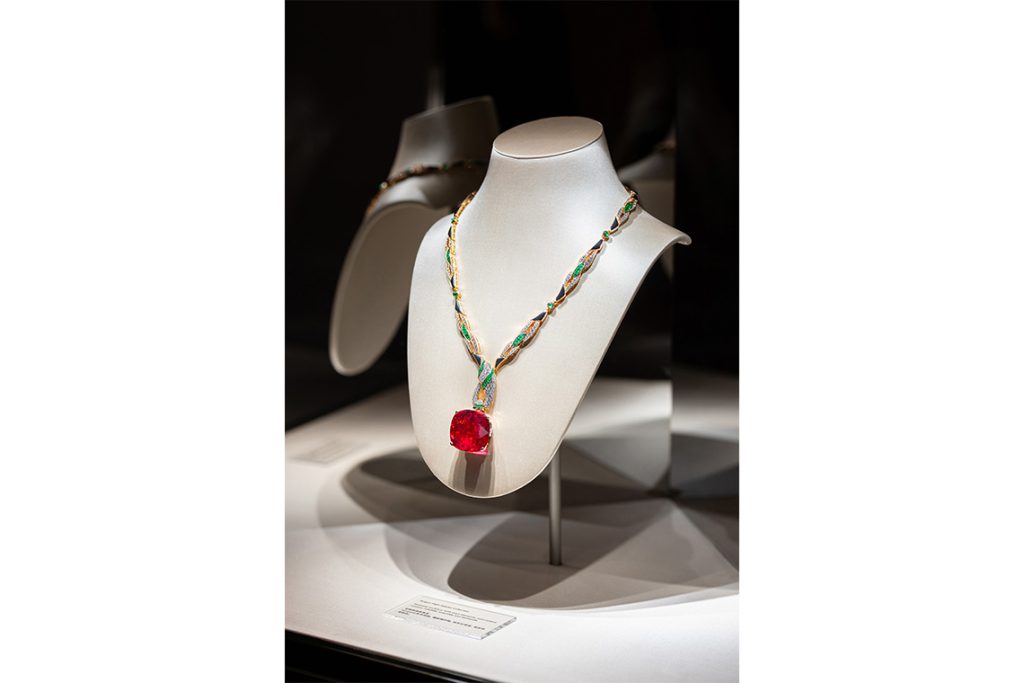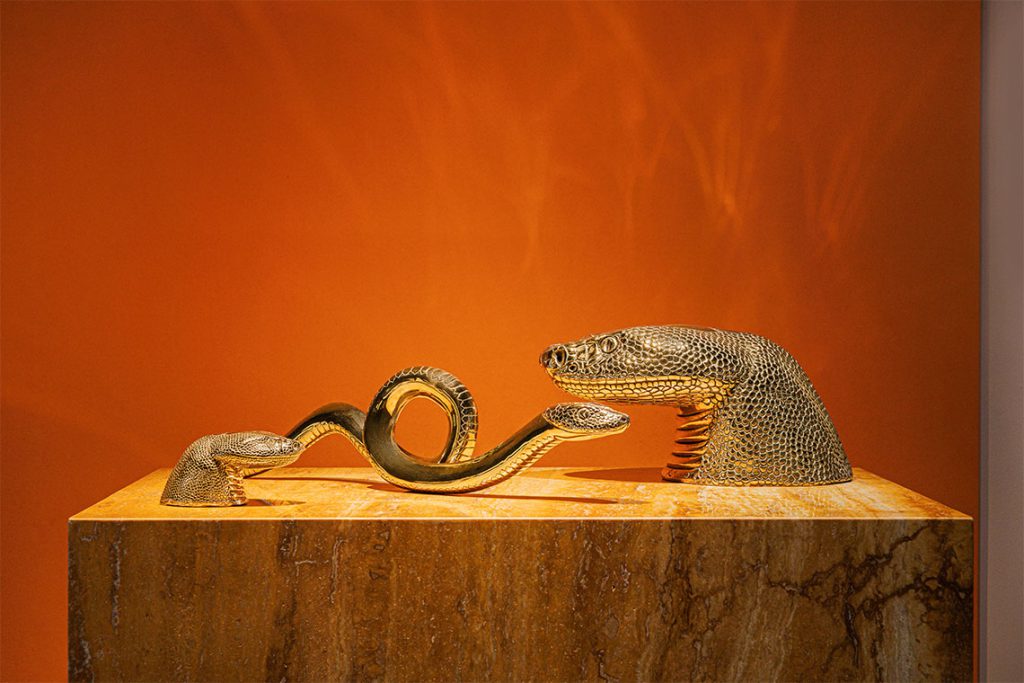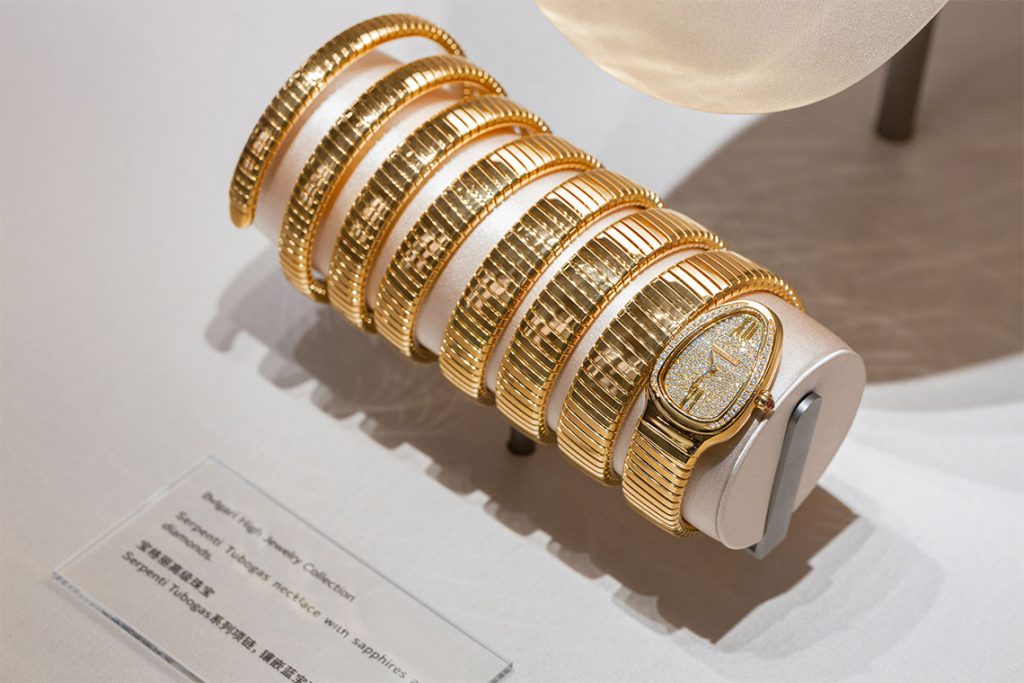The snake has been a significant force throughout history, impacting fields from biology through to the arts, but it begs the question: why? Through its latest exhibition, SERPENTI INFINITO, the Roman High Jeweller Bvlgari rejuvenates the discourse around the dualistic nature of a creature which draws us in as much as it repels us.
“Across the vast expanse of the cosmos, the spirit of the serpent weaves universal secrets.”
from the Bvlgari SERPENTI INFINITO exhibition in Shanghai
Snakes have been with us for a very long time. They first appeared around 100–120 million years ago on the supercontinent of Gondwana, with different types evolving simultaneously. Today almost 3000 species have been recognised scientifically, spread across every continent except Antarctica and many of which use venom to disable their prey. Greatly diverse in terms of size, coloration and behaviour, they live in almost every type of habitat and often in close proximity to humans. Their presence traditionally engendered senses of fear, awe and fascination. It comes as no surprise therefore that our own social and cultural history is inextricably linked with the realm and symbolism of the serpent.
Snakes have given rise to myriad myths, beliefs and values spanning creation and wisdom through to fear and wickedness. Some of the most prominent associations are with Adam and Eve in the Garden of Eden, or as a medical emblem for the last 2000-plus years, courtesy of a link to the Greek god of medicine, Asclepius (etymologically harking to askalobos, an ancient Greek word for ‘snake’). The perspective of a snake garnering a more positive, learned connotation when wrapped around a staff of knowledge was reinforced by Renaissance philosophers, who took the medical symbol to reference deliverance and redemption, as well as the literal provider of antidotes. Even today, the majority of the medical world continues to use this motif. Another derivation with ancient Greek provenance is the ouroboros, a symbol representing rejuvenation and the cyclical nature of life in the form of a snake eating its own tail. A similar expression appears in the 14th-century BCE Enigmatic Book of the Netherworld funerary text on the tomb of the Egyptian pharaoh, Tutankhamun.
Serpentine symbolism has endlessly oscillated and occasionally shape-shifted, quite literally. Civilisations in Central America variously felt snakes represented wisdom and protection, as well as possessing supernatural and/or life-giving powers, while in North America the perception was largely threatening, save for the Hopi people, who believe that snakes are guardians of springs and vectors through which water (in the form of rain) is brought to their desert home. In Africa, some sub-Saharan belief systems would invoke the python during hard times (such as periods of war, flood and famine) as a deity of charity, wisdom and fertility. In parts of Asia, such as ancient Mesopotamia, the snake was referenced (and killed) in the Epic of Gilgamesh (c.2100 BCE), one of the earliest major works of literature, as a fearsome creature serving the god of earth, wind and air and which protected a cedar forest. This notion of the snake as a protector likewise appears in Greek writings from the fifth century BCE, when the historian Herodotus described how frankincense groves in Arabia were guarded by snakes. In other Asian cultures, serpents are largely worshipped – known as ophiolatry – and believed to have auspicious connotations. They feature heavily in Chinese histories, with tales such as The Legend of the White Snake purportedly predating written documentation. In creation stories found across Buddhism, Hinduism and Jainism, one finds the Naga, an individual or grouping of serpent gods. Similarly, Australian Aborigine histories credit the origin of the world to the Rainbow Serpent, which appears in rock art depictions dating back more than 6000 years.

necklace. Image courtesy of Bvlgari
The multifaceted snake has long been a focus for artists in particular. It appears in classical sculptures such as Statue of Young Hercules (late second–early third century CE), where the boy holds up a snake in his fist; in lithographs including US pop artist Keith Haring’s USA 19– 82 (1982), which depicts an anthropomorphic ouroboros working its way through a nimbused figure with outstretched arms; and in the blue-grey monochromatic portrait The Sin (1909) by German painter Franz Von Stuck, who was predominantly inspired by mythology. The creatures also feature in objects discovered in archaeological digs such as the 4000-year-old wooden snake discovered in Finland and the 1600 BCE Minoan figurines unearthed in Crete and on which snakes crawl or are held by women, as well as in furniture: Eileen Gray’s 1917–18 modernist Dragon’s Chair remains the most expensive chair ever sold at auction.
More recent artistic interpretations include those by Chinese artist Qiu Anxiong, who has long involved serpents in his life and practice. “Snakes have always fascinated me because they are rarely seen in everyday life and possess a uniquely mysterious and dangerous aura,” he explains. “I can’t fully explain why I am so intrigued by them, but I actively sought out stories and images about snakes. One of the most memorable was a book titled Snake Island, which described an island in northern China’s Bohai Bay which was inhabited entirely by venomous vipers.” In addition to keeping them as pets, after graduating from university Qiu incorporated a large snake he purchased from a Chongqing street vendor into an installation and performance piece before releasing it into the mountains.
In 2024, he returned to the idea of the snake as part of a special commission for Bvlgari, inspired by a story from Strange Tales from a Chinese Studio (Liaozhai Zhiyi). “I first encountered this story as a child, around eight or nine years old, and revisited it many times,” he says. “There is a particularly moving moment when a human and a snake meet again and recognise each other, which brought me to tears.” The artistic result was a green snake with a red gemstone-like orb on its head. “These experiences have taught me to respect snakes and avoid disturbing them when I encounter them in nature,” Qiu affirms.
We have long been culturally attuned to snakes. Items of jewellery featuring the reptiles have been found in Western Asia as far back as the prevalence of snakes in the decorative arts is courtesy of their non-exhaustive conceptual potential. Few have been as consistently committed – both aesthetically and academically – as Bvlgari. Excavating serpentine mythologies, the Maison has paid homage to the creature through its haute jewellery, watches and leather goods collections, educational and heritage initiatives, and artistic and cultural patronage. It also champions snakes through exhibitions such as the travelling 2016 SerpentiForm and the 2023 Bvlgari Serpenti 75 Years of Infinite Tales, hosted in Dubai and which featured works by the Emirati artists Dr Azra Khamissa, Dr Afra Atiq and Azza Al Qubaisi, alongside a digital AI projection by the Turkish artist Refik Anadol. In a further celebration, Utopic Arabia’s the Serpenti Odyssey (2024) took viewers on an intriguing voyage from ancient Rome to the Middle East in the tracks of a snake’s mythical path. Some of these artists return to Shanghai with new and existing collaborations. The Maison’s initiatives also extend to publications, such as Serpenti in Art (2016), which outlines the cultural significance of the snake across the globe.

Observing the intimate relationship between the snake and Bvlgari, it becomes clear that when harnessed creatively, fear and wonder can build a powerful legacy. Drawing upon the ever-evolving symbolic potential of the skin-shedding creature which bridges cultures spanning East to West, Bvlgari’s metamorphic Serpenti emblem likewise embodies endless innovation. Perhaps inspired in part by the shop of curiosities created by Sotirio Bulgari, the founder of Bvlgari, its evolution has drawn upon numerous conceptual and aesthetic influences ranging from Eastern mythology to humanity’s enduring pursuit of self-awareness and insight. The resulting Bvlgari collections have seen the original simple, minimalist snake shape assume a tubular form, become stylised and encrusted with gems, covered with multi-coloured enamels and shaped through creative and cutting-edge goldsmithing techniques. It has adopted zoomorphic qualities, undergone ultra-modern reinterpretations and even been included within advertising campaigns as a symbol
of infinity. More recently, Serpenti Viper creations have incorporated new colours of gold, with or without diamonds; four Serpenti rings boasting a more figurative reference are set to be launched in select boutiques; and the 1968 Serpenti Harlequin jewellery-watch embellished with multicoloured enamel sees new life in the form of the Serpenti Cuore 1968 bag.
Tapping into the deep-seated human fascination with snakes, Bvlgari and now invites the world to SERPENTI INFINITO, an exhibition exploring how these reptiles have embedded themselves in collective consciousness. Opened in January 2025 – the Chinese Year of the Snake and Bvlgari’s own Year of Serpenti – at Zhang Yuan, Shanghai’s recently refurbished architecture complex-cum-cultural landmark, the showcase celebrates the Chinese interpretation of the snake in myriad forms. The exhibition unfolds in three chapters: Crafting Serpents in History, Snakes in the Arts, and Contemporary Transformations. Curators Gislain Aucremanne, Bvlgari Heritage Curator Director, and Cao Dan, Chinese publisher, curator and documentary filmmaker, have set out to illustrate what they call a snake’s “liquid wisdom”, inviting visitors to understand and appreciate the cultural and artistic contribution of the serpent and its diverse qualities, both physical and metaphorical.
Arranged in a serpentine manner, the exhibition features antique Chinese artefacts, including jade rings with serpent patterns, a bronze ritual vessel He Zun with a winding snake motif, and a robe woven with python designs – something for the history-minded. A second perspective oriented towards jewellery aficionados sees a careful assemblage of 11 Bvlgari Serpenti designs from collections past and present. Early pieces recall the expressive brushstrokes of Eastern painting tradition and paid homage to China’s jade legacy with a dedicated Gallery at the Maison’s flagship Roman boutique in the 1960s. On view is the iconic 1968 Serpenti Tubogas bracelet-watch crafted in 18K gold, adorned with 43 cabochon-cut jade stones weighing approximately 44 carats.
The third angle introduces commissioned contemporary artworks. Twenty-eight artworks, of which 11 were created exclusively for the occasion, are presented by 19 artists including Qiu, Xu Bing and Xue Feng from China, alongside international talents such as Refik Anadol and Azza Al Qubaisi. Each expresses the snake within their own cultural contexts and through media ranging from light art and AI to installation and sculpture. For Xu, an award-winning artist and academic, serpents represent “constant transformation and intelligence”, he says. For the Bvlgari commission, he wrote ‘serpenti’ in his own Square Word Calligraphy script, a writing system in which his combination of Chinese and English characters forms a new linguistic concept. “Viewers may experience confusion at first, but ultimately will have an ‘aha’ moment,” explains Xu. “This piece adds a Chinese character-like form to Western calligraphy, and the symbol of the snake, which appears in many cultures, is particularly fitting here. The flowing brushstrokes of Chinese calligraphy are also inspired by the snake’s twisting movements.” The effect created by Xu encourages reconsideration of previously accepted perspectives of snakes and their qualities.

A more cautious approach was adopted by Xue, a painter, upon receiving the commission. “I have always had a deep fear of snakes, yet I find myself profoundly intrigued by visual works featuring them. There is an instinctive psychological response I experience, something that I cannot fully articulate but always feel strongly,” he reveals. “The curatorial team presented me with one of my earlier works, which took me by surprise. They reminded me of the hidden potential within my own compositions – a capacity to evoke serpentine spaces.” This rediscovery led to Infinite Door, further inspired by Xue’s observation that jewellery has a uniquely sinuous and fluid aesthetic trajectory. “For Bvlgari, I have created a ‘serpentine space’ awash with vibrant colours, evoking an infinite sense of spatial extension. As viewers allow their gaze to linger on the artwork, they are invited into a realm of boundless imagination, compelling them to explore the unseen.”
While the exhibition’s fil rouge is focused on craftsmanship, it is underpinned throughout by the thematic undertones of the serpentine qualities of wisdom, protection and power. In the show’s second section, Bvlgari highlights the primacy of a harmonious coexistence between humanity and nature, affirming that “each creation holds the secrets of nature and the core of human civilization, allowing its wearer to connect deeply with nature and symbolising the drive to grow and transcend oneself”. The significance of this relationship is further asserted in the third section of the exhibition, where the High Jewellery collection interprets infinity and spirituality through gemstones set according to the iconic Tubogas technique, which sparked the entire Serpenti motif, and incorporated in pieces featuring the celebrated Möbius strip, another trademark Bvlgari skill.
The myriad efforts of historians, scientists, psychologists, patrons, artists and craftspeople over many centuries have seen enormous advancements in terms of human understanding of the snake, its physiognomy and behaviour. Yet with all this ever-accessible knowledge, have we lost something less tangible as a result? “This accessibility has diminished the creature’s sense of mystery and power,” laments Qiu. Despite this shift, some things never change: we remain transfixed by the snake. “It is evident that animals possess emotions, intelligence and even a sense of morality,” he continues. “Their extraordinary range of behaviour, which may seem inexplicable to us today, was once naturally accepted within the ancient worldview of animism – a perspective that saw all living beings as equal and intricately interconnected.
Myths, in essence, were expressions of this understanding of the world.” Qiu affirms that in our contemporary age we must re-examine and re-establish this relationship and how, through SERPENTI INFINITO, viewers are invited to rediscover this lost understanding of the bond between humanity and the natural world. The exhibition “serves as a reminder that our lives do not exist in isolation but are deeply interconnected with the world around us,” he concludes.
This feature first appeared in Canvas 116: Time After Time



